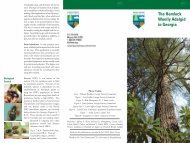Field Guide to the Identification of Cogongrass - Georgia Forestry ...
Field Guide to the Identification of Cogongrass - Georgia Forestry ...
Field Guide to the Identification of Cogongrass - Georgia Forestry ...
You also want an ePaper? Increase the reach of your titles
YUMPU automatically turns print PDFs into web optimized ePapers that Google loves.
C. Evans, UGA<br />
Key <strong>Identification</strong> Features <strong>of</strong> <strong>Cogongrass</strong><br />
Plant Base<br />
- No apparent stem<br />
- Leaves appear <strong>to</strong> arise directly from<br />
or close <strong>to</strong> <strong>the</strong> ground<br />
- Overlapping sheaths give a rounded<br />
appearance <strong>to</strong> <strong>the</strong> plant base<br />
- All vegetation doesn’t arise from one<br />
dense clump, instead <strong>the</strong> plants are<br />
more spread out<br />
- Light-green <strong>to</strong> yellowish in color, or<br />
could be reddish<br />
- Often a lot <strong>of</strong> thatch around base<br />
Leaf collar/Ligule<br />
- Ligule is a thin-fringed membrane<br />
- Leaf sheaths overlapping, giving <strong>the</strong> plant a round appearance<br />
- Hairy (<strong>the</strong> ligule is <strong>the</strong> most hairy part <strong>of</strong> <strong>the</strong> plant, <strong>the</strong> plant base may<br />
also be somewhat hairy)<br />
3<br />
R. Carter, VSU<br />
J. Miller, USFS<br />
J. Miller, USFS<br />
C. Evans, UGA



